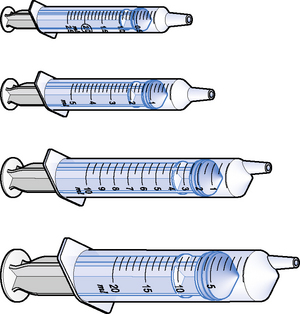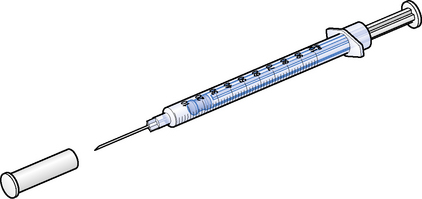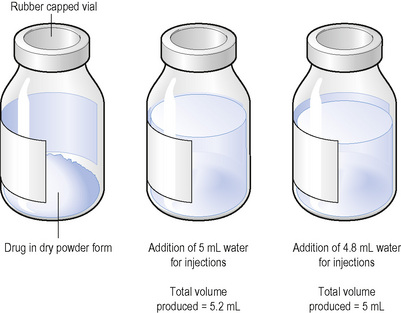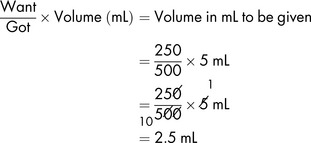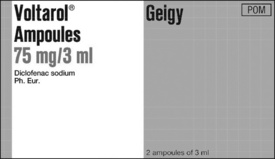Chapter 5 Calculating parenteral doses
small volume
Introduction
Following discussion of some of the essential elements of calculating doses of parenteral drugs, examples of calculations are presented at the different levels of complexity described in Chapter 3. They are presented in the same three ways as in Chapter 4, namely:
All answers are given on p. 195.
Equipment for measuring the dose
Medicines for injection are presented in either a glass or plastic ampoule (Fig. 5.1), a rubber-capped vial (Fig. 5.2) or a prefilled syringe or a cartridge (Fig. 5.3). The contents are either in the form of a liquid or presented as a powder requiring reconstitution. To aspirate the contents, a syringe and needle of suitable size are selected. Care must be taken to draw up the correct amount into the syringe. It is therefore essential to appreciate the significance of the calibrations on different syringes (Fig. 5.4). The syringe should be held at eye level and air should be expelled. The reading should be taken at the top of the black bung attached to the plunger of the syringe. When drawing up and giving insulin, a syringe (with integral needle), specifically for insulin calibrated in units, will normally be used (Fig. 5.5).
Displacement volumes
A number of drugs are unstable in solution (both parenteral and oral) and are therefore supplied in dry powder form. Prior to administration, the powder must be reconstituted using a diluent (or solvent). Water for injections is commonly used but sodium chloride 0.9% solution may be the recommended diluent; on occasion, a specially formulated diluent may be provided. Enough liquid is needed to dissolve (or suspend) the contents to produce a concentration that prevents irritation of body tissues but at the same time is of minimum volume so as to make the injection less painful.
The addition of 5 mL of a diluent to a vial containing 500 mg of a drug in powder form will produce a volume of more than 5 mL due to the presence of the powder (Fig. 5.6). It can be seen in Fig. 5.6 that the powder has added 0.2 mL to the volume of diluent added. The displacement volume (DV) is the volume of liquid displaced by the powder, in this case, 0.2 mL. If the dose to be administered is less than 500 mg, it will be important to take account of the displacement value (Cable 2008).
To obtain the required dose, the usual formula can then be applied:
Displacement volumes will normally be found in the product literature. If for some reason the DV is not known, a suitable volume of diluent is added to the vial in the usual way and the powder fully dissolved. The total contents of the vial are measured by drawing into a syringe. The required dose can then be calculated.




